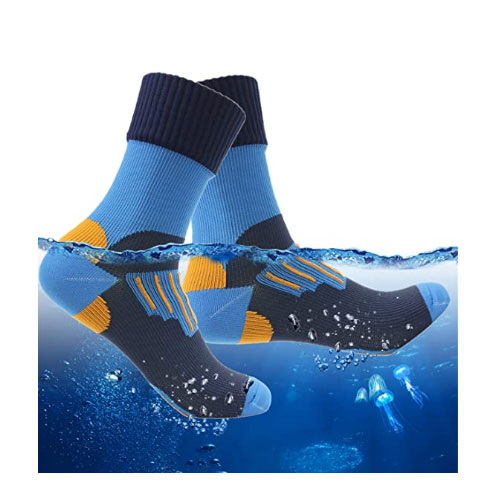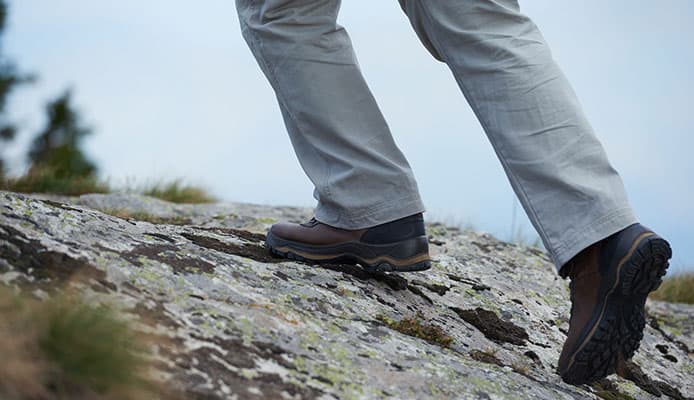
Socks have been keeping feet warm and preventing sweaty feet since the ancient Greeks first wore them in the 8th century BC. The first waterproof sock was made in 1914 to reduce trench foot cases during World War I. Given how miserable wet socks and soggy feet are, it is surprising that it took so long for waterproof socks to be invented.
Now that we have this ingenious invention, wet feet shouldn’t ruin your outdoor experiences whether you love kayaking, fishing, hiking, camping, climbing, cycling, running, or work or train outside in moist, wet, muddy, swampy, rainy or snowy conditions. A pair of waterproof socks will offer your feet the dry comfort and protection you need in these conditions.
The best waterproof socks protect feet from wet from both the outside and inside to keep feet comfortably dry and healthy. They are impervious to water from the outside but also breathable and moisture-wicking so they let your feet breathe and allow perspiration to escape to the outside. The pairs we’ve reviewed below meet these requirements, are well made to last, and have proven their performance in rainy and watery situations. We have also put together a buying guide to help you pick the perfect waterproof socks to suit your needs.
Ready to get started? Let’s go.
OUR TOP PICK
DexShell Ultralite Bamboo
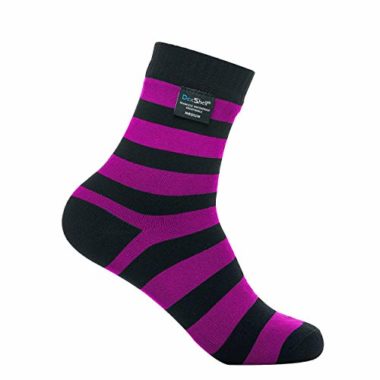
- Stand Out Features - Why We Love It
- Repel water
- Comfortable to wear
- Breathable, moisture-wicking and seamless comfort
- Quality and durable construction
- Ultralight and not bulky
- Seamless construction
- Can also be used as hiking socks
- Perfect to keep your feet dry
EDITORS CHOICE
Randy Sun Skiing Knee Length
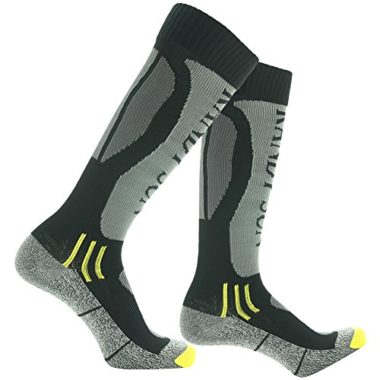
- Stand Out Features - Why We Love It
- Versatile and suitable for a variety of activities
- Knee length offers optimal leg coverage
- Excellent waterproof and windproof protection
- Nice balance of waterproofing, insulation, and breathability
- Fully seamless for comfort
- Elasticated for fit, comfort, and mobility
- Unisex sizing with a variety of styles
BEST VALUE
Randy Sun
- Stand Out Features - Why We Love It
- Waterproof, breathable, and warm
- Anti-bacterial odor protection
- 100% seamless and cushioned sole for comfort
- SGS certified quality
- A wide range of unisex designs and sizes
- Abrasion resistant
BROTOU
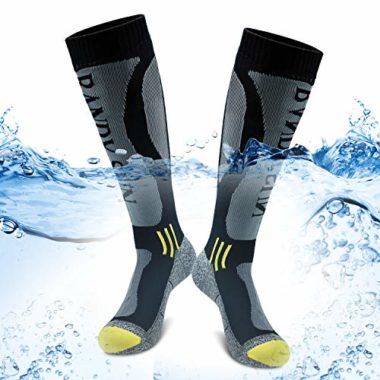
- Stand Out Features - Why We Love It
- Waterproof and windproof
- Breathable and moisture-wicking
- Well made and durable
- Thermal and anti-bacterial protection
- Comfortable to wear
- Unisex style and sizing
- Can also be used as hiking socks
Rocky Men’s Gore-Tex
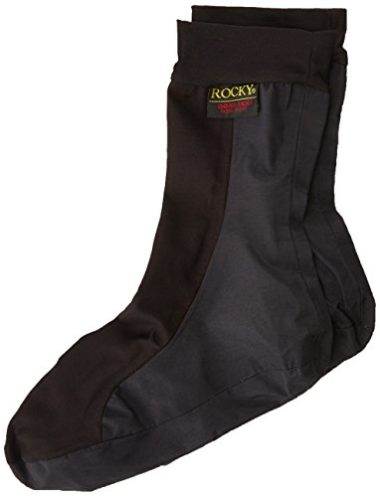
- Stand Out Features - Why We Love It
- Waterproof and breathable
- High quality and durable construction
- Superior and reliable GORE-TEX performance
- Abrasion resistance exterior
- Perfect for keeping your feet dry in all situations
NRS HydroSkin
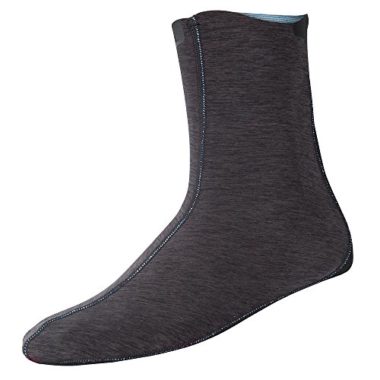
- Stand Out Features - Why We Love It
- High quality and durable
- Stretchy for comfort and mobility
- Durable water repellent coating
- Well insulated to offer thermal protection
Showers Pass Crosspoint WP Crew
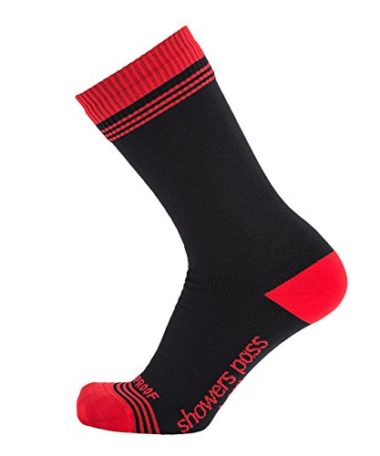
- Stand Out Features - Why We Love It
- Waterproof and windproof
- Breathable and moisture-wicking
- Antibacterial and blister protection
- Non-bulky and seamless comfort
- Perfect to keep your feet dry
Sealskinz Knee Length
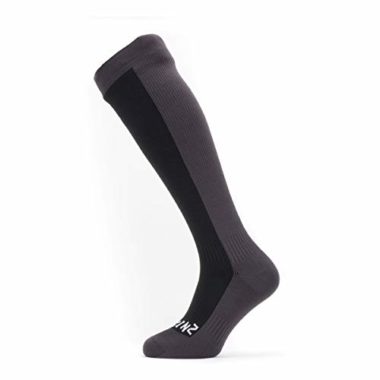
- Stand Out Features - Why We Love It
- Knee-length coverage and versatility
- 100% waterproof and windproof
- Breathable and moisture wicking
- Thickness and merino wool lining offers warmth
- Comfortable and supportive ergonomic design
- Secured by a lifetime guarantee
- Can also be used as hiking socks
Junlan Neoprene
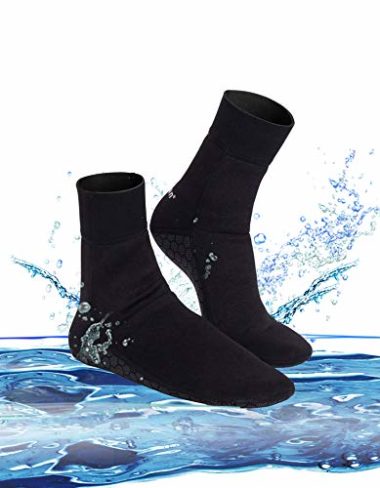
- Stand Out Features - Why We Love It
- Neoprene construction keeps feet warm
- Fully waterproof water socks
- Well made for performance, comfort, and durability
- Inexpensively priced and incredible value
- Tight and adjustable cuff fit
Hanz Submerge Calf-Length
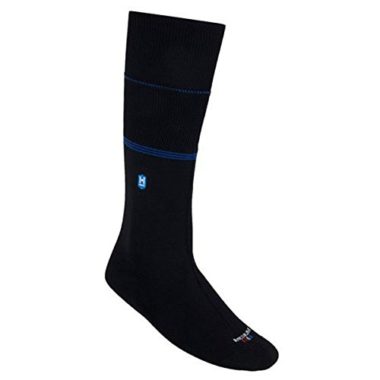
- Stand Out Features - Why We Love It
- Submersible and pressure tested for leaks
- Completely waterproof with a tightly sealed top
- Breathable and moisture wicking
- Seamless construction for comfort
- Stretch fit design offers a comfortable fit
- Quality and durable 3 layer build (abrasion resistant)
- Perfect to keep your feet dry
How To Choose A Pair Of Waterproof Socks – Buying Guide
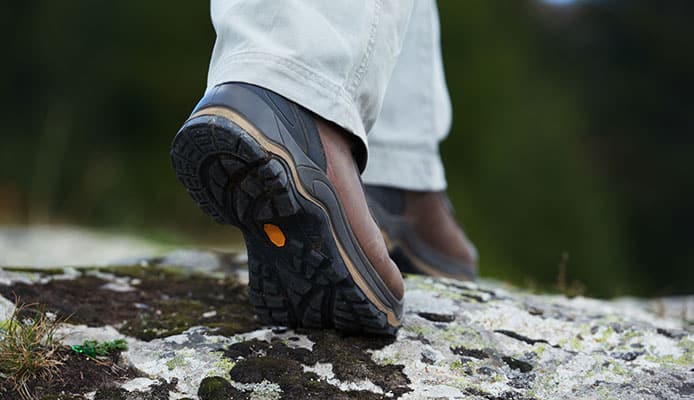
There are all kinds of waterproof and waterproof socks on the market. So how do you choose a pair that will keep your feet comfortably dry? Will just any pair work as long as it is waterproof? There are some factors you should pay attention to ensure the pair you invest in will serve you well out there. When shopping for waterproof socks consider the following features:
Breathability
You want a pair of socks that will protect you from moisture from both the outside and inside. Not a pair that will block water from getting into your feet but get your feet soggy wet due to sweat accumulation. This is why it is important that you choose socks that are also made to be breathable and moisture-wicking.
When active outdoors, it is inevitable that your feet will sweat. Breathable socks let sweat vapor escape to the outside and moisture-wicking fibers absorb perspiration moisture and release it to the outside so your feet stay cool and dry and don’t develop blisters and chafing.
To be both waterproof and breathable, these socks use a three-layer construction. Wear and water-resistant outer later that resembles regular socks, a waterproof yet breathable membrane, and a soft lining that feels comfortable on the skin but is breathable and moisture-wicking.
Material
The material the socks are made of is very important as it will determine their waterproof performance, breathability, durability, and comfort. A pair of waterproof socks will be made using a variety of materials to make the outer sock, the waterproof and breathable membrane, and the inner lining that is contact skin. Here are the different socks materials you will come across when shopping for your socks and what you can expect from them.
Bamboo fiber or bamboo rayon is made from bamboo. It is soft, breathable, wicks moisture, provides thermal protection, and is anti-bacterial.
Wool is able to absorb and retain up to 30% of its weight in moisture and still feel dry. It is quick-drying and naturally resists odors. Merino wool is soft, strong, resilient, and anti-static. It is superior to other wools, as it is finer, less itchy, more elastic, and is breathable as well as insulating so it keeps feet warm and dry in cold conditions and cool and dry when it’s warm.
Polyester is quick-drying and insulating in cold weather but get hot in warm weather. It has excellent resistance as it is resistant to water, mildew, tearing, shrink and stretch and chemicals. Modern polyester fabrics are soft, breathable, and moisture-wicking.
GORE-TEX is waterproof and has excellent breathability and durability. It also comes with an expensive price tag.
Coolmax is a breathable polyester fabric that wicks perspiration and also offers insulation. Some yarns even have antibacterial properties.
Porelle is flexible, lightweight, and durable. Porelle membranes repel water from getting in but have micropores that let sweat vapor escape to the outside of the socks.
Nylon is water-resistant, lightweight, elastic, abrasion-resistant, and durable. It is the most common material for the outer socks.
Acrylic is a soft and warm synthetic fabric with similarities to wool. It washes easily and is colorfast and UV resistant.
Elastane/spandex and lycra are used to add some stretch to waterproof socks for flexibility and a comfortably snug fit.
Neoprene is a type of synthetic rubber that is waterproof, stable, and flexible in a wide range of temperatures. It provides excellent insulation in cold conditions but doesn’t breathe very well in warm weather.
Cotton is soft with excellent breathability and feels very comfortable on the skin. It is also hypoallergenic if you have sensitive skin and lasts long. However, pure cotton waterproof socks absorb water, get wet, and become a soggy mess. Modern technology has produced new cotton fibers that repel water, wick moisture, and last even longer.
Size
A snug fit is essential in waterproof socks so as to ensure they are really watertight. It is important to order a size that will fit you snugly.
Sock sizing is not standard and tends to vary from manufacturer to manufacturer and even among styles by the same brand. Some brands size their socks for men and women according to shoe sizes while some have unisex sizing with extra small, small, medium, large, and extra-large sizes. Most waterproof socks are also designed with a stretch for a comfortably snug fit.
The best way to ensure you order your right size is to take your feet measurement and compare them with the size chart of the pair of socks you’re planning to order.
It is also important to choose the right length for the depth of water you will be using them in. Choose a sock length that is longer than the water depth to ensure water doesn’t get in from the top. There are ankle, crew, mid-calf, and knee-length socks.
Also, choose the right sock weight and thickness for the kind of insulation or comfort you need. Because of the layered construction, waterproof socks tend to be thicker than regular socks. Keep this in mind given the shoes or boots you will be wearing them with.
Performance
The most important performance feature of waterproof socks is their waterproof protection. You will want to ensure you get a pair that can really keep your feet dry when out there. First of all, waterproof, water-resistant, and water repellent doesn’t mean the same thing.
Top-rated waterproof socks are made to be completely impervious to water and will keep your feet dry even when your feet are immersed in water for a prolonged duration. These waterproof socks are able to resist some level of water intrusion and can offer adequate protection in mildly wet conditions and for short durations. However, they will get drenched if your feet are immersed in water for an extended duration. Water repellent means that the outside sock layer is coated so that water beads and slides down instead of seeping through.
A sufficient waterproof sock length and a cuffed seal are also important to ensure that water doesn’t get inside the socks from the top and get your feet wet defeating the purpose of wearing waterproof socks in the first place. A completely waterproof pair of socks that is also sealed at the top is so excellent at keeping water out from the feet that it can be used as a shower sock.
Their performance in preventing sweaty feet is also an important consideration. If your waterproof socks are going to keep your feet comfortably dry, it should allow your feet to breathe and have the ability to wick moisture from perspiration to the outside of the socks so your feet don’t overheat and become sweaty.
Comfort is also essential and the socks you go for should feel good on your skin. Fully seamless construction, cushioning, ergonomic design for support, and an elasticized fit will ensure a pair of waterproof socks offer the comfort, protection, and performance you need.
Warmth
The only thing worse than wet feet is cold and wet feet. If you’re looking for the perfect waterproof socks for winter, cold water, and snowy conditions, the ability to keep your feet warm, as well as dry, is very important. Feet are very sensitive to cold as our bodies reduce blood circulation to the feet and hands when it is cold.
Thick waterproof socks featuring insulated linings made of materials like merino wool keep feet warm. Waterproof socks made of neoprene are excellent at providing warmth although this thermal protection often comes at the expense of breathability.
If you will be active in snowy conditions such as when skiing or skating, a mid-weight and insulated socks will be sufficient. If you will be standing immobile in cold water or ice such as when fishing, you need very thick and well-insulated socks.
You might also be interested in:SIMARI Womens And Mens Water Shoes SWS002 Review
Durability
Even top-rated waterproof socks won’t last forever but they should offer you some years of service without losing their performance. To ensure your waterproof socks are good quality and will withstand water exposure, harsh conditions, and constant friction, look for quality features like the use of quality materials, outer layer build to withstand abrasion, seamless construction, reinforced and padded toe and heel. Check user reviews to get an idea of how well a pair of waterproof socks you’re considering holds up with use in the great outdoors.
Activity
Not all waterproof socks are suitable for all activities. Keep in mind which activities you will be participating in when wearing your socks so you can choose the best waterproof socks for those situations.
Thin and ultralight socks are best for running, cycling, golf, and other activities in warm weather where insulation for warmth isn’t essential. If you’re looking for the best waterproof socks, they need to be breathable, a comfortable thickness and weight and built to suit the kind of terrain you will be hiking in.
Thick waterproof socks made with wool or neoprene such as the neoprene socks Rei makes provide warmth when engaging in snow activities, and other cold-weather and winter sports. Waterproof socks for swimming are made of neoprene and so are waterproof socks designed to be worn with swim or snorkeling fins or wetsuits.
FAQs
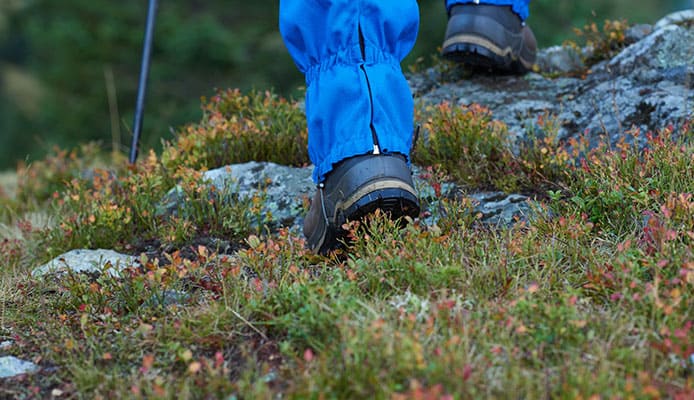
Q: Who Needs Water Resistant Socks?
Outdoor enthusiasts, as well as anyone who spends time, trains, or works in wet, rainy, muddy, and snowy environments, need socks that keep their feet healthy and dry.
Wet feet are no joke. Apart from soggy feet, misery, prolonged and repeated wetness can lead to all kinds of health issues such as chafing, blisters, cracks, athlete’s foot, trench foot, and even frostbite.
Whether you love surfing, fishing, kayak fishing, climbing, biking, hiking, skiing, golfing, camping, hunting, kayaking, or enjoy running, gardening, walking or work outside in construction, farming or transit, good socks will keep your feet dry and comfortable when around or in water or mud. You will love your socks and wonder how you ever lived without them.
Q: How Do I Wash Water Resistant Socks?
To keep your socks in good condition for a long time, hand washing using normal temperature water and a mild liquid detergent is recommended. Rinse thoroughly and hang to dry. After some time, turn them inside out so they dry completely.
If you prefer to machine wash, only use the delicate cycle and water temperatures under 40°C/104°F. Do not dry clean, bleach, tumble dry or iron your socks, as the structure of the waterproof/breathable membrane is affected by heat and harsh chemicals. Make sure to read and follow the manufacturer’s care instructions.
Q: How Do I Wear Water Resistant Socks?
Ensure your feet are clean and dry before you wear your socks. They should fit snugly but not so tight that they restrict circulation. For even more comfort and warmth, you can put on a pair of regular socks underneath the waterproof ones. You can then wear appropriate outdoor shoes or boots for the kind of activity you will be engaging in.
Q: What Size Should I Buy?
Sock sizing is not standard and socks can run large or small depending on the manufacturer or style. The best way to ensure you order the right size for a comfortably snug fit is to take your feet measurement and compare them with the size chart of the pair of socks you’re planning to order.
Keep in mind that most socks are designed with a stretchy fit and tend to be thicker than regular or athletic socks. Ensure you choose a sock length that is longer than the depth of water you will be wearing your socks in to ensure water doesn’t get in from the top.
Q: Do Your Feet Get Sweaty When You Wear Water Resistant Socks?
It is inevitable that your feet will sweat when you wear these socks because you will be active and outdoors. If your socks are not designed to be breathable and wick away the sweat moisture and excess warmth, your feet will get sweaty and clammy.
This is why it is important to go for a pair that is both waterproof and breathable so it is able to wick away perspiration from your feet and allow the vapor from evaporating sweat to escape to the outside so your feet don’t get sweaty and wet from the inside.
Globo Surf Overview
Outdoor activities and conditions are tough on feet. It is very important to have the right kind of footwear that offers comfort and protection. This is especially when spending time in moist, wet, rainy, muddy, and snowy conditions. A pair of socks is one of the most important accessories to ensure your feet stay dry and healthy.
Whether you love cycling, running, hiking, hunting, work or train outside, don’t let wet and muddy conditions ruin your outdoor experiences and feet health. Keep your feet comfortably dry by wearing top-rated water proof socks that suit your activity. They will block water from outside and also wick away moisture from sweat preventing sweaty feet.
With a good pair of socks on, you will stay comfortable, keep your feet healthy and maximize your enjoyment of your favorite activity. You will never wear regular socks for outdoor activities in moist conditions ever again.


